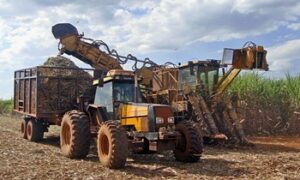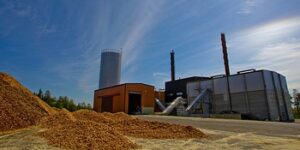A major new book examines the potential for sustainable growth of bioenergy use, potential impacts, and the role of good governance in maximizing benefits and avoiding harm.
Crushing sugarcane at a Raízen mill in Brazil. Flickr / Shell

Over the past two years, 137 experts from 24 countries and 82 institutions, including SEI’s Francis X. Johnson, have collaborated to analyse a range of issues related to the sustainability of bioenergy production and use. The resulting report, Bioenergy & Sustainability: Bridging the Gaps, was launched on 14 April. Below, Johnson answers questions about the assessment’s key findings and their implications for public policy.
Q: There is a huge volume of literature on bioenergy out there. How does this book fit in?
FXJ: It brings together the different dimensions into one reference volume, covering land, water, soils, food security, climate, energy access, ecosystems, biodiversity, economics, conversion technologies and energy security. It serves as scientific reference, but also for policy-makers and general audiences.
Q: The project was led by experts in Brazil, a country that has been a pioneer in biofuels production. How does that affect the perspective of the book as a whole?
FXJ: A country like Brazil that has done well with bioenergy naturally produces scientists who are optimistic, which results in what some may consider a positive spin. But this counters a recent tendency in Europe and U.S. to oppose bioenergy on conservationist grounds. That perspective might work for industrialized economies, but for developing countries with largely agrarian economies, modern bioenergy is too valuable for global market access, poverty reduction and energy security to simply dismiss it.
Q: What would you say are the most important insights/messages from the book as a whole?
FXJ: A key message is that society cannot afford to forgo the benefits of biofuels done well – just as it cannot afford the risks of biofuels done badly (see also this 2009 Science article). Constraining bioenergy, as is being done in the EU, mainly supports the fossil fuels status quo; instead, we should be doing bioenergy better while also reducing energy demand. The Assessment also shows that as we move to integrated systems, we cannot analyse liquid biofuels in isolation from other markets, surrounding landscapes, and other bio-based products.

Harvesting sugarcane in Piracicaba, Saõ Paulo, Brazil. Wikimedia Commons / Mariordo
Q: You are co-author of three chapters, most notably one on bioenergy and food security, also the subject of your book Food versus Fuel. Why has bioenergy raised such concerns, and how do you address them?
FXJ: A report leaked from the World Bank in 2008 suggested that biofuels were responsible for 75% of food price increases. Later estimates were 10–15% or lower (see Chapter 4). The same is true of indirect land use change impacts of biofuels; in 2008, they were estimated at levels 5–10 times higher than what has been found recently, even with the same models (see Table 17.3 in the Assessment). So a lot of early misinformation has gained a lot of attention.
Food prices are not a major issue for the rural poor, who grow their own food, but they are a serious concern for the urban poor. Rejecting biofuels on those grounds, however, places the burden of helping the poor on farmers, whereas in ethical terms, the whole society should take responsibility. The goal is to increase yields and exploit synergies with modern bioenergy in the agri-supply chain, creating a valuable domestic energy source.
Additional income for farmers and improved community energy access have knock-on effects: innovation and agri-businesses reduce the vulnerability of rural areas. Subsistence agriculture and traditional biomass can degrade considerable land with little return; improving agricultural productivity while adding bioenergy and other bio-based products improves food security.

Traditional biomass use in India. Flickr / McKay Savage
Q: You also co-authored the “numbers” chapter. How much has bioenergy grown in recent years, and is there still a lot more potential?
FXJ: There has been considerable growth in liquid biofuels and biomass for heat and power, while biogas remains small. However, the largest share of bioenergy is still traditional biomass for cooking and heat in developing countries. Replacing that with modern bioenergy yields 5–10 times as much energy for the same quantity of biomass. So in global terms the goal is to use land and biomass resources better rather than using more.
The mistake many NGOs and scientists make is to assume a static system in which bioenergy is added on top of other demands – but the point is to catalyse improvements and create synergies over time. Biomass can increase its share even as feedstock and land use decline. For example, Sweden has more than tripled its bioenergy production since the 1970s, nearly all from domestic woody sources, yet its forested area has actually increased. It is all about good management practices.
Q: The assessment identifies Latin America and Africa as the areas with the greatest bioenergy growth potential. Are there other areas where bioenergy growth should be discouraged?
FXJ: Densely populated regions (e.g. South Asia) and water-scarce areas (e.g. South Africa) face constraints with bioenergy, though they can use wastes and residues and, in some cases, use degraded lands. Regions with sensitive and unique ecosystems (e.g. the Amazon) should generally not be used for bioenergy, and some regions are risky just because they fall in the rainforest belt. But with the exception of palm oil, few bioenergy crops would be suitable in rainforest areas anyway.
Another point is that developing countries have weaker institutions. Some argue that we should not invest in modern bioenergy for that reason, because it will likely go wrong. That could have been said about Brazil in the early 1970s – but it’s a double standard. It says, “We don’t trust you to develop this form of renewable energy responsibly,” but does not stop those countries from exploiting or using fossil fuels, or from growing sectors such as mining and IT, that further concentrate wealth. It would be better to support those countries in strengthening their institutions to improve overall land use governance for agriculture and forestry as well as for bioenergy.
Learn more about the book Bioenergy & Sustainability (external link)

The biomass-fuelled Kalix combined heat and power plant in northern Sweden. Flickr / Vattenfall
Design and development by Soapbox.

